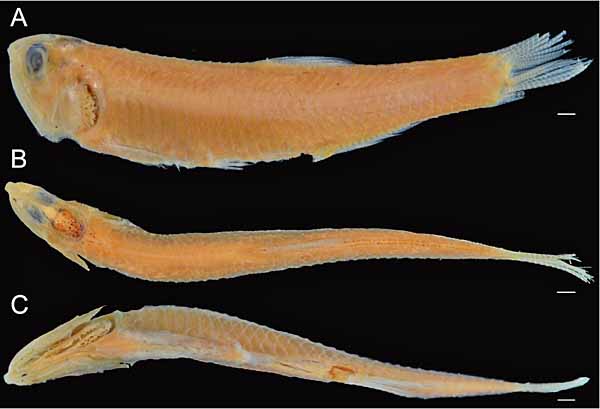Stolephorus bengalensis
(Dutt & Babu Rao, 1959)
|
Familie: Engraulidae SynonymeAnchoviella baganensis bengalensis Dutt & Babu Rao, 1959 Lokale Bezeichnung |
Typen
Neotypus: USNM 276476 .
Siehe: Eschmeyer, W.N., Fricke, R. & Van der Laan, R. (eds.) 2024. Catalog of Fishes electronic version
Typusfundort: ursprünglicher Fundort: Waltair und Kakinada, Andhra Pradesh, Ostküste Indiens; Typuslokalität des Neotypus: Kilakarai, Golf von Mannar, Indien.
Etymologie
Benannt nach der geografischen Region Bengalen im Nordosten des indischen Subkontinents, in dem auch die Typuslokalität liegt.
Verbreitung
Nördlicher Indischer Ozean: Pakistan bis Golf von Bengalen.
IUCN Status

EX Extinct (ausgestorben)
EW Extinct in the Wild (in der Natur ausgestorben)
CR Critically Endangered (vom Aussterben bedroht)EN Endangered (stark gefährdet)
VU Vulnerable (gefährdet)
NT Near Threatened (potenziell gefährdet)
LC Least Concern (nicht gefährdet)
RE Regionally Extinct (regional oder national ausgestorben)DD Data Deficient (ungenügende Datengrundlage)
NE Not Evaluated (nicht beurteilt)
Status: Stand 5.10.2022: NE Not Evaluated (nicht beurteilt)
Gefahren für diese Art: (nicht beurteilt)
Literatur
- Dutt, S. & Babu Rao, M. 1959. Occurrence of Anchoviella baganensis Hardenberg off east coast of India. Current Science, 28 (4): 160-161. Zitatseite [:160, !!, als Anchoviella baganensis bengalensis]
- Whitehead, P.J.P. 1967. The clupeoid fishes described by Lacepède, Cuvier and Valenciennes. Bulletin of the British Museum (Natural History) Zoology Suppl. 2: 1–180, Pls. 1–11. Zitatseite [: 18, z.T.: Bay of Bengal, als Stolephorus baganensis macrops (Lapsus Memoriae für Stolephorus megalops)]
- Whitehead, P.J.P., Nelson, G.J. & Wongratana, T. 1988. FAO species catalogue vol 7. Clupeoid fishes of the world (suborder Clupeoidei). An annotated and illustrated catalogue of the herrings, sardines, pilchards, sprats, shads, anchovies and wolf-herrings. Pt 2 – Engraulidae. FAO Fisheries Synopsis, no 125. FAO, Rome, i–viii + 305–579. Zitatseite [:405, als Synonym von Stolephorus baganensis; :413, z.T.: nördlicher Teil des Indischen Ozeans, als Stolephorus insularis]
- Young, S.-S., Chiu, T.-S. & Shen, S.-C. 1994. A revision of the family Engraulidae (Pisces) from Taiwan. Zoological Studies, 33 (3): 217–227.(PDF) Zitatseite [: 222, fig. 7 (Wangkun und Fangliao, Taiwan), als Stolephorus insularis]
- Wongratana, T., Munroe, T.A. & Nizinski, M.S. 1999. Order Clupeiformes. Engraulidae. Anchovies. In: Carpenter, K.E. & Niem, V.H. (eds): FAO species identification guide for fishery purposes. The living marine resources of the western central Pacific, vol 3. Batoid fishes, chimaeras and bony fishes pt 1 (Elopidae to Linophrynidae). FAO, Rome, pp 1698–1753. Zitatseite [:1736, z.T.: (nördlicher Teil des Indischen Ozeans), als Stolephorus insularis]
- Kottelat, M. 2013. The Fishes of the Inland Waters of Southeast Asia: A Catalogue and Core Bibliography of the Fishes Known to Occur in Freshwaters, Mangroves and Estuaries. The Raffles Bulletin of Zoology, Supplement No. 27: 1–663. (PDF) Zitatseite [:55, als Synonym von Stolephorus baganensis]
- Hata, H. 2019. Family Engraulidae. Pp. 199–210 in:
- Koeda, K. & Ho, H.-C. (eds) 2019. Fishes of southern Taiwan. National Museum of Marine Biology & Aquarium, Pingtung. Zitatseite Zitatseite [:206, unnum. Abb. (Ke-tzu-liao, Ziguan District, Kaohsiung, Taiwan), Stolephorus bengalensis --> Stolephorus eldorado]
- Hata, H., Lavoué, S. & Motomura, H. 2019. Taxonomic status of seven nominal species of the anchovy genus Stolephorus described by Delsman (1931), Hardenberg (1933), and Dutt and Babu Rao (1959), with redescriptions of Stolephorus tri (Bleeker 1852) and Stolephorus waitei Jordan and Seale 1926 (Clupeiformes: Engraulidae). Ichthyological Research, 67: 7–38. (doi) Zitatseite [:18, 21, Neotypus festgelegt, z.T.: 24, fig. 12 (Pakistan und Indien) als Stolephorus bengalensis; :24, z.T.: fig. 12a, b, (Taiwan; Hainan Island, China; Ha Long Bay, Vietnam; Gulf of Thailand; Songkhla, Thailand; Kuala Terengganu, Terengganu, Malaysia), Stolephorus bengalensis --> Stolephorus eldorado]
- Gangan, S.S., Pavan-Kumar, A., Jahageerdar, S. & Jaiswar, A.K. 2020. A new species of Stolephorus (Clupeiformes: Engraulidae) from the Bay of Bengal, India. Zootaxa, 4743 (4): 561-574. (doi) Zitatseite [:562, fig. 5, (Kochi, Kerala State, India), als Stolephorus insularis]
- Hata, H., Koeda, K., Aizawa, M., Sakamoto, K. & Ueshima, R. 2022. A list of Clupeiformes (Actinopterygii: Teleostei) specimens deposited in the Department of Zoology, The University Museum, The University of Tokyo. The University Museum, The University of Tokyo. Bulletin, 128: 17–58. Zitatseite [:34, z.T.: Wenzhou City, Zheijiang Province, China, Stolephorus bengalensis --> Stolephorus eldorado]
- Hata, H., Lavoué, S. & Motomura, H. 2022. Description of three new species previously identified as Stolephorus bengalensis (Dutt & Babu Rao, 1959) or Stolephorus insularis Hardenberg, 1933 and a re-description of S. bengalensis (Chordata, Osteichthyes, Clupeiformes, Engraulidae). ZooKeys, 1121: 145-173. (doi) Zitatseite [:149, Figs 2, 3, Wiederbeschreibung, Farbfoto, als Stolephorus bengalensis]
